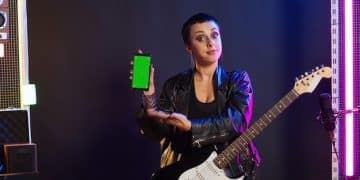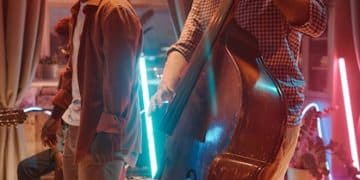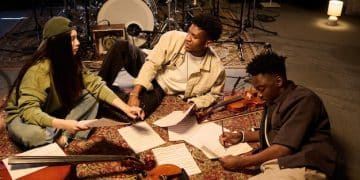Emerging Artists’ Guide to Music Promotion: Reaching New Fans
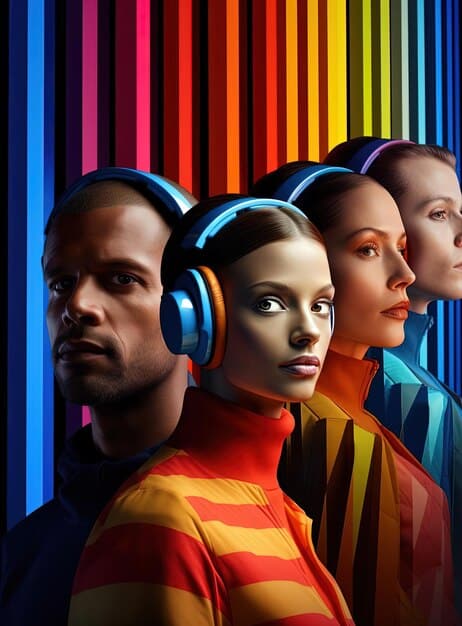
Navigating the competitive music industry requires emerging artists to master diverse promotion strategies, from digital engagement to traditional networking, to effectively reach new fans and cultivate a sustainable career path in an ever-evolving landscape.
Embarking on a music career as an emerging artist’s guide to music promotion: strategies for reaching new fans can feel like navigating a complex maze. The landscape of music consumption and discovery is constantly shifting, demanding adaptability and innovative thinking. This guide aims to demystify the process, offering actionable insights for building a robust promotional strategy that genuinely connects with new listeners and amplifies your artistic voice.
Building Your Digital Footprint: The Foundation of Modern Promotion
In today’s interconnected world, an artist’s digital presence is paramount. It’s not merely about existing online; it’s about curating a compelling narrative that resonates with potential fans. This involves a strategic approach to various platforms, each with its unique audience and functionality.
Firstly, consider your artist website. While social media platforms offer immediate reach, your website is your definitive online home—a place where you control the narrative, design, and content without algorithmic restrictions. It serves as a central hub for all things related to your music, from discography and tour dates to merchandise and press kits. Make it easy to navigate, visually appealing, and mobile-friendly.
Optimizing Your Online Presence
Beyond your website, strategic engagement on key digital platforms is crucial. Each platform offers distinct opportunities for reaching different segments of your target audience. Understanding their nuances allows for more effective content creation and distribution.
- Social Media Synergy: Don’t just post; engage. Platforms like Instagram, TikTok, and YouTube are visual and sound-driven. Leverage short-form video for behind-the-scenes glimpses, creative snippets, or musical challenges. Use trending audios and hashtags to increase discoverability.
- Streaming Platform Strategy: Spotify, Apple Music, and other streaming services are where many fans discover new music. Focus on getting your music on editorial playlists, submitting to algorithmic recommendations, and encouraging listeners to save your tracks. Distribute your music broadly through a reliable distributor.
- Email List Building: While often overlooked, an email list remains one of the most powerful direct communication channels. Offer exclusive content, early access to releases, or personalized updates to encourage sign-ups. This direct line bypasses algorithms and ensures your message reaches your most dedicated fans.
Moreover, consider the broader digital ecosystem. Engage with online music communities, participate in forums, and collaborate with other artists. Each digital interaction contributes to your overall online footprint, reinforcing your brand and expanding your reach organically. The goal is to create a cohesive and engaging digital presence that invites exploration and fosters loyalty.
Ultimately, a strong digital footprint demands consistency. Regularly update your platforms, respond to comments, and analyze your analytics to understand what resonates most with your audience. This data-driven approach allows for continuous refinement of your strategy.
Leveraging Content Marketing: Beyond Just Songs
Content marketing in music is about providing value beyond the recorded tracks themselves. It’s about building a narrative, showcasing your personality, and giving fans a reason to connect more deeply with your artistry. This approach transforms passive listeners into engaged followers and advocates.
Think about the stories behind your songs. What inspired them? What was the creative process like? Share these insights through various content formats. Video content, in particular, has become indispensable, offering a dynamic way to portray your artistic journey and connect with your audience on a personal level.
Diversifying Your Content Portfolio
To truly capture attention, your content strategy needs to be multifaceted. Relying solely on snippets of your latest song won’t suffice. Explore different content types that showcase your versatility and provide unique entry points for new fans.
- Behind-the-Scenes: Show the making of your music, studio sessions, songwriting process, or even a glimpse into your daily life as a musician. Authenticity builds connection.
- Live Performance Clips: Share snippets from your gigs, whether acoustic sets, band rehearsals, or full performances. This can range from high-quality concert footage to casual phone videos.
- Storytelling and Personal Insights: Use blogs or longer-form video to delve into the themes of your music, your inspirations, or personal anecdotes. This helps fans understand the depth of your artistry.
Another powerful aspect of content marketing is educational or instructional content. If you play an instrument, consider tutorials or tips. If you write lyrics, discuss your approach to songwriting. This positions you as an expert and broadens your appeal to different audiences.
Remember that consistency is key. Develop a content calendar and stick to it. This doesn’t mean producing high-budget videos every week, but rather maintaining a steady stream of engaging content that keeps your audience captivated. The more compelling and diverse your content, the greater your chances of being discovered and shared.
In essence, content marketing is about creating a rich tapestry around your music, giving fans more reasons to love and support your work. It’s a long-term investment that yields significant returns in fan engagement and loyalty.
The Power of Collaboration and Networking: Expanding Your Reach
No artist thrives in isolation. Collaboration and networking are indispensable tools for expanding your reach, learning new skills, and discovering fresh perspectives. These interactions can unlock opportunities that might otherwise remain out of reach, from co-writing to sharing fanbases.
Begin by identifying other artists, producers, and industry professionals whose work you admire or whose audience aligns with yours. Reach out thoughtfully, proposing mutually beneficial projects or simply establishing a connection. Authentic relationships are the bedrock of effective networking.
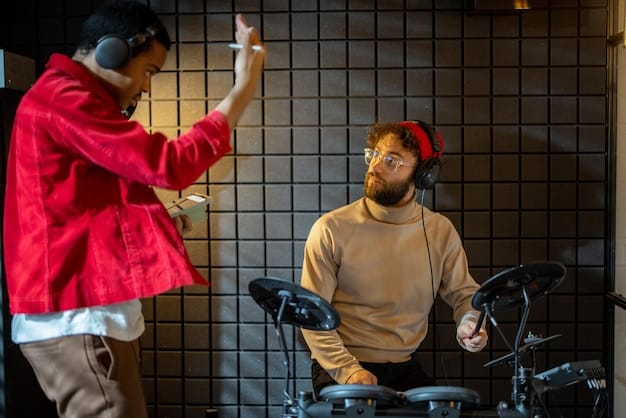
Strategic Collaborations and Partnerships
Collaborations extend beyond just making music together. They can encompass joint performances, shared content creation, or cross-promotion efforts. The goal is to leverage each other’s strengths and audiences to achieve greater impact.
- Co-writing and Production: Working with other songwriters or producers can refresh your sound, challenge your creative process, and introduce you to new working methods. This often leads to unique tracks that surprise and delight fans.
- Joint Performances/Tours: Partnering with another artist for a show or a small tour can split costs, attract a larger combined audience, and introduce your music to new listeners.
- Content-Based Collaborations: Create joint YouTube videos, TikTok challenges, or Instagram Live sessions. This cross-pollination of content exposes both artists to each other’s followers, expanding reach effectively.
Networking isn’t confined to online spaces. Attend local open mics, industry events, and workshops. These face-to-face interactions often lead to more meaningful connections. Be prepared to introduce yourself and your music concisely, and always follow up graciously.
Furthermore, consider unconventional partnerships. Could your music fit a particular brand’s ethos? Are there non-profits you resonate with for a charity single? These collaborations can open doors to placements in advertisements, film, or even gain exposure through corporate sponsorships.
Ultimately, collaboration and networking are about building a supportive community around your music. These relationships can provide invaluable support, mentorship, and opportunities as you navigate your artistic journey.
Navigating Live Performances: Connecting in Person
While digital promotion is crucial, nothing truly compares to the visceral experience of a live performance. It’s an unparalleled opportunity to connect directly with your audience, convey the emotion in your music, and convert casual listeners into dedicated fans. Live shows are vital for building a genuine following and creating memorable experiences.
Start small, in local venues, cafes, or open mics. These intimate settings allow you to hone your craft, test new material, and observe audience reactions. As you gain confidence and experience, gradually seek out larger venues and festivals.
Maximizing Your Live Show Impact
A successful live performance isn’t just about playing your songs; it’s about creating an immersive and engaging experience. Every element, from your stage presence to your sound quality, contributes to the overall impression.
- Engage Your Audience: Interact with the crowd between songs. Share stories, ask questions, or invite participation. Create a feeling of intimacy and shared experience.
- Merchandise and Sign-ups: Always have merchandise available (even if it’s just stickers or CDs). Crucially, have a way for people to sign up for your email list. Offer an incentive, like an exclusive track.
- Professional Sound and Lighting: Work with sound engineers and lighting technicians to ensure your performance sounds and looks its best. A professional presentation elevates the entire experience.
Beyond traditional venues, explore alternative spaces for performances. Could you play in a park, a bookstore, or even a unique pop-up event? These unconventional settings can attract different audiences and generate buzz. Consider busking in high-traffic areas, which can be an excellent way to gain exposure and earn some income.
Also, don’t underestimate the power of support slots. Opening for a more established artist can introduce your music to a larger, pre-existing audience. Research local bands in your genre and respectfully reach out to their management or directly to the artists to inquire about support opportunities.
Each live performance is an opportunity to leave a lasting impression. Invest time in rehearsing, refining your stage presence, and promoting your shows effectively. The energy and authenticity you bring to the stage will resonate with audiences and build a loyal fanbase one show at a time.
Public Relations and Media Outreach: Telling Your Story
Public relations (PR) is about strategically shaping how the media and public perceive you and your music. It’s not just about getting reviews; it’s about telling your unique story, building credibility, and generating buzz. While often daunting, effective PR can amplify your message far beyond your direct reach.
Start by identifying publications, blogs, podcasts, and radio stations that align with your genre and target audience. Personalize every outreach. Mass emails rarely yield results. Research the editor or host and explain specifically why your music would be a good fit for their platform.
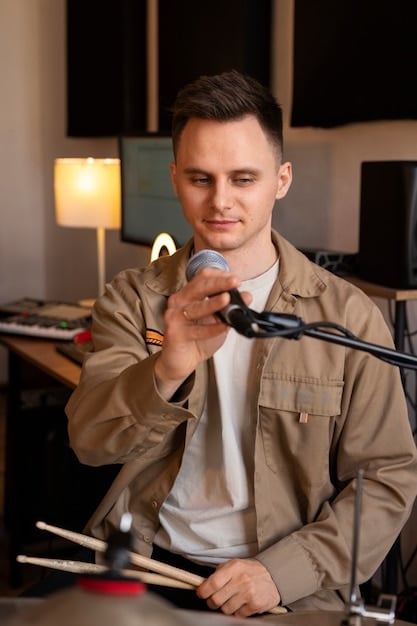
Crafting Your Press Kit and Pitch
A well-prepared press kit is essential. It acts as your professional introduction to media outlets, providing them with all the necessary information to cover your story efficiently and accurately.
- Professional Bio: A concise yet compelling summary of who you are, your musical journey, and your artistic vision. Tailor it for different contexts (short for social, longer for interviews).
- High-Quality Photos: Professional press photos are critical. They convey your artist brand and are necessary for media features. Include a variety of shots (headshots, full body, performance shots).
- Music Links: Provide easy access to your music, preferably private (SoundCloud, Bandcamp) links for unreleased material, and public links to streaming services for released tracks. Highlight your best or most relevant songs.
- Press Releases/Clippings: If you have notable achievements (e.g., new release, tour announcement, awards), include a well-written press release. If you’ve been featured before, include links to those articles.
When pitching, focus on what makes your story unique. Is there a compelling narrative behind your latest song? Have you overcome significant challenges? Is your music part of a larger cultural trend? The stronger your story, the more likely it is to capture media interest.
Beyond traditional media, explore opportunities with social media influencers and content creators in the music sphere. A mention or feature from a popular TikToker or YouTuber can generate significant organic reach. Build relationships with these creators who genuinely appreciate your style.
Remember that PR is a marathon, not a sprint. Be persistent, but always respectful. Follow up appropriately, and be prepared for both success and rejection. Each piece of coverage, no matter how small, contributes to building your overall media presence and credibility.
Monetization and Sustainability: Fueling Your Music Career
While passion drives artistic creation, building a sustainable music career requires a clear understanding of monetization strategies. Diversifying your income streams allows you to reinvest in your craft, fund promotional efforts, and ultimately dedicate more time to music. It’s about creating a robust financial ecosystem around your artistry.
Consider the various avenues available beyond just streaming royalties, which are notoriously low for emerging artists. These additional income streams can be crucial for bridging the gap between passion and profession.
Diversifying Your Revenue Streams
A multi-pronged approach to income generation provides stability and future growth potential:
- Merchandise Sales: T-shirts, hats, stickers, vinyl, or digital bundles can be significant income sources. Design unique and appealing merchandise that fans genuinely want to own.
- Sync Licensing: Licensing your music for use in film, TV, commercials, or video games can provide substantial upfront fees and exposure. Explore music libraries and sync agents.
- Direct-to-Fan Platforms: Utilize platforms like Bandcamp or Patreon, where fans can directly support your music and artistry through purchases or subscriptions, often receiving exclusive content in return.
- Performance Fees: As you gain traction, secure fair performance fees for your gigs. This includes live shows, online concerts, and private events.
Explore grants and funding opportunities available to artists. Many cultural organizations, foundations, and government programs offer financial support for new projects, touring, or professional development. Research eligibility criteria and invest time in crafting compelling applications.
Consider teaching music lessons or offering workshops, if you have the skills. This not only generates income but also solidifies your expertise and connects you with a new community. Leverage your musical abilities beyond performance and recording.
Ultimately, a sustainable music career is built on a foundation of creative output, strategic promotion, and savvy business practices. By diversifying your income streams, you empower yourself to continue creating, performing, and reaching new fans without constant financial strain.
Analytics and Adaptation: Refining Your Strategy
In the dynamic world of music promotion, relying on intuition alone is not enough. Strategic growth demands a data-driven approach, constantly analyzing what works, what doesn’t, and adapting your tactics accordingly. Understanding your audience and the effectiveness of your efforts is key to sustained progress.
Every major platform, from Spotify for Artists to YouTube Analytics, provides valuable insights into your audience demographics, listening habits, and content engagement. Don’t let these numbers intimidate you; they are powerful tools for refinement.
Interpreting Data and Making Adjustments
The wealth of data available can be overwhelming, but focusing on key metrics can provide actionable insights for your promotional efforts:
- Audience Demographics: Who are your listeners? Where are they located? This information helps you tailor content and target ads more effectively.
- Engagement Rates: Are people commenting, sharing, and liking your content? High engagement indicates your content is resonating.
- Platform Performance: Which platforms are driving the most traffic to your music? Where are new fans discovering you? Double down on successful channels while experimenting with others.
Track your growth over time. Are your streaming numbers increasing? Is your social media following expanding? Are more people signing up for your email list? Identify trends and correlations between your promotional activities and your audience response.
Be prepared to pivot. If a particular promotional strategy isn’t yielding results, don’t be afraid to try something new. The music industry evolves rapidly, and what worked last year might not be effective today. This adaptability is a hallmark of successful, enduring artists.
Regularly review your objectives. Are you aiming for more streams, more live show attendees, or more merchandise sales? Align your promotional activities with your current goals and measure against them. This iterative process of analysis and adjustment ensures your efforts remain focused and efficient.
Finally, remember that analytics tell a story, but they don’t replace creativity. Use data to inform your decisions, but always allow room for artistic expression and experimentation. The goal is to blend strategic insight with authentic artistry.
| Key Promotion Area | Brief Description |
|---|---|
| 🌐 Digital Foundation | Establishing a strong online presence on websites, social media, and streaming platforms. |
| 📝 Content Marketing | Creating engaging, diverse content beyond just music to build deeper fan connection. |
| 🤝 Collaboration & Net. | Expanding reach through strategic partnerships with other artists and industry professionals. |
| 📊 Analytics & Adapt. | Using data to refine promotional strategies and adapt to industry changes. |
Frequently Asked Questions
▼
An artist website is crucial as it serves as your primary online hub, offering complete control over your content and brand narrative. Unlike social media, it’s not subject to algorithmic changes, ensuring direct access for fans to your music, merchandise, and tour dates, consolidating all your information in one professional space.
▼
Instagram, TikTok, and YouTube are currently among the most effective platforms for music promotion due to their visual and sound-driven nature. Utilizing short-form video, engaging with trending content, and showcasing behind-the-scenes glimpses can significantly boost discoverability and fan engagement for emerging artists.
▼
Emerging artists should focus on both live performances and digital promotion, as they serve different yet complementary purposes. Digital promotion offers broad reach and discoverability, while live performances provide unparalleled opportunities for direct fan connection and memorable experiences. A balanced strategy maximizes overall impact and growth.
▼
Collaborations can significantly benefit emerging artists by expanding their reach to new audiences, fostering creative growth through shared projects, and building valuable industry relationships. Partnering with other artists, producers, or content creators allows for cross-promotion and exposure to diverse fanbases, accelerating career momentum.
▼
Sync licensing involves granting permission for your music to be used in visual media like films, TV shows, commercials, or video games. It’s important for musicians because it can provide significant upfront revenue, offer broad exposure to new audiences, and add perceived value and legitimacy to an artist’s catalog, creating a valuable income stream.
Conclusion
The journey for emerging artists in music promotion is multifaceted, demanding a blend of digital savviness, creative content generation, strategic collaborations, and genuine in-person connections. By embracing a holistic approach that integrates a strong online presence with compelling live performances, thoughtful media outreach, and diverse monetization strategies, artists can systematically build a loyal fanbase and carve out a sustainable career. Continuous adaptation through data analysis is not merely a suggestion but a necessity in this ever-evolving industry, empowering artists to not only find their audience but also to truly thrive and leave an indelible mark.
